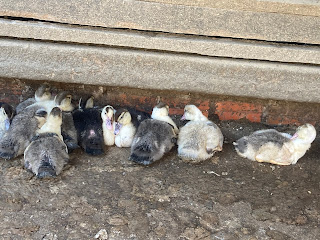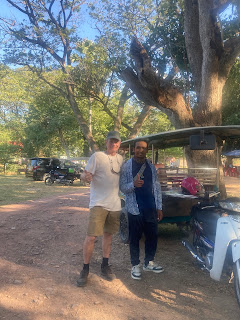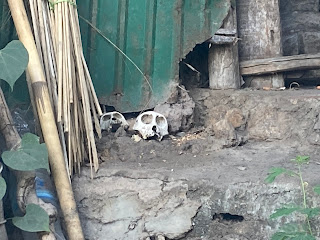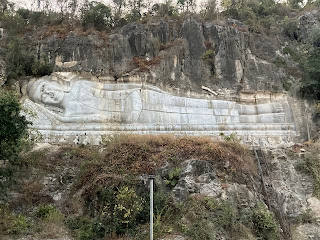January 16th, 2025
For my first day in Battambang, I hired a tuk tuk driver
through the guesthouse for a day trip to a variety of sites/attractions around
the area. My driver introduced himself
to me as Peter, but I later asked what his real name was, not the simple name
for tourists, and it was Pisat. He spoke
English quite well and was a slow driver on his motorcycle tuk tuk with a
trailer (which I appreciated as I could enjoy the scenery more…even though I
still missed a number of great photo opportunities as we cruised around).
We headed south from the city of Battambang and passed
through a quieter area where the houses were more spread apart. Our first stop was to check out three men who
were chipping away on sandstone slabs, creating works of art. In the yard, there was a big Buddha carving
that was waiting for its pedestal to be finished. Pisat explained that their customers were
either temples or rich people who wanted to proudly display these statues or
carvings in their yards.
We pulled over at a small farm with a stall by the roadside selling goose eggs and a handful of different fruits, most of which I was not familiar with. The farm lady came out to greet us and Pisat asked if I would like to try a few of the fruits…sure, why not? We walked around the yard, checking out the chicken coop, the ducks, various plants and even the outside of their traditional Cambodian house. When we returned to the stand, the woman had prepared a small plastic bag with slices of guava and of a type of grapefruit fruit for me. There was an extra, small bag inside that had some salt and spices in it. Dipping the bits of guava into it made it more appealing, but there was a bit of a kick to the spices.
Next on the agenda was “The Hanging Bridge”. I felt like this one was just added to make it seem like there was a lot on the tour, and in fact, there was a lot already…but whatever. It was an old, rusty suspension bridge with a wooden deck wide enough to accommodate a scooter or motorcycle, or two people walking side by side. I walked out to the middle of the span, snapped a few photos and then came back to the tuk tuk.
I asked Pisat whether there was a toilet nearby, and sure
enough, across the road was a temple complex with one. After taking care of nature’s call, I
wandered through by the main temple and met up with Pisat at the far side. It was 11 am, which seemed to be lunchtime
for a nearby school as a number of bicycles with cute kids, often a bigger one
giving a double to a smaller one, passed by.
Our next stop literally was a stop, a train stop for the
smallest train I’ve ever been on. Known
as a bamboo train, but
originally known as “norries”, it gets its name from the fact that the way they
used to be propelled was by a long bamboo pole pushed against the ground,
similar to how a gondola moves through the water. Pisat explained that these tiny platforms,
also made with some bamboo for the base to sit on, were used to move big bags
of rice from the farms to a collection point.
Nowadays, they simply use cargo trucks to pick up the rice, and the
bamboo trains have just turned into a tourist attraction.
In researching things to do in Cambodia, I saw “bamboo
trains” and it is one of the main reasons I came to check out Battambang. I’ve always liked riding on trains, and when
I saw a photo online of what this was about, I had to come and give it a
go. It’s unique experiences like this
that I love about travelling, like when I went “volcano
boarding” in Nicaragua or “hydrospeeding”
in Colombia.
For $10 USD, I had my own “train” and engineer (ironically,
I’m listening to a radio station online right now as I type this and the song
is “Crazy Train” by Ozzy Osbourne!). The
journey would be about 4 kilometres down the track, and back again, which would
take about 20-30 minutes. My train
engineer was a young guy, only about 20 years old, who didn’t speak much
English. To start, he pushed our little
train down the track, hopped onboard and fired up the little portable engine
that was connected to one of the train axles by a fan belt.
Cruising down the tracks at around 35-45 km/h, the click
clacking of the wheels was methodic and entrancing…but combined with the
engine, a bit loud. I couldn’t help but
feel sorry for the local people with houses by the track, who have to tolerate with
the noise of these tiny tourist trains passing by all day.
In the distance I could see a speck on the track, which grew
and grew in size. It was another bamboo
train returning to the “station”. We
slowed down as we approached them. The
protocol seemed to be that outbound trains yielded to inbound ones. So I hopped off my train, the driver of the
other train helped my guy to lift off our train’s platform to the side of the
tracks. Then the two axles with the
wheels were picked up, the other train moved passed us, and the procedure was
done in reverse to get us back on our way.
It only took a matter of a couple of minutes.
We reached the end point, which seemed somewhat arbitrary,
but there were some simple shops with clothes, souvenirs, snacks and cold
drinks for sale. Our train was
disassembled for the last time to allow three other trains to head back in the
opposite direction.
Ten minutes later, after declining various sales pitches
from the shop owners, I was back on the bamboo train, heading back to the
starting point.
It was a super cool experience, and just the right amount of
time (or earplugs might have been required!).
Next on the list was checking out some fruit bats. As the name implies, these large bats
primarily eat fruits for their diet, which does not endear them to the local
population. Farmers shoot them when they
can. We pulled over to the side of the
road and there were two or three large trees filled with fruit bats, hanging
upside down and trying to sleep. I asked
Pisat if they were found in other trees around the Battambang area as it seemed
like this was a known spot to find them as some other tourists showed up a few
minutes later, on a similar tour. Across
the road was a temple and because of that, the bats were safe here and had somehow
figured that out. No local would dare
shoot them in the proximity of this holy place…interesting. I actually saw fruit bats in December
2023 in Rwanda on Napoleon Island.
And in that situation, we were able to get much closer to them as they
were in trees on a steep hillside, plus many more of them were flying around
(which is awesome to watch), so this stop was not a big highlight of the day,
but still good.
Wat Banan
was next on the list as the day just kept rolling. It was now after 2 pm and both I and Pisat
hadn’t had lunch yet, so that was the first priority. There were a number of food stalls, but Pisat
seemed to have his favourite one, and was friends with the lady running
it. Situated right by a small lake, it
was a nice spot to sit down for a bite to eat.
There was a menu, with some western-ish options on it like fried rice
but I decided to get whatever Pisat was going to order…why not go with the
local? It was simply rice with some beef
(the traditional dish is called Lok Lak) and a bit of lettuce and
tomatoes. It was tasty and filled a gap.
Now it was time to climb the 300 or so steps up to the
temple. At the top, there were 4-5 steep,
cone-like temples made from large carved stones. It felt like I was doing a warmup for
visiting Angkor Wat. I only spent about
10 minutes at the top of the hill, snapping some photos, and then headed down.
Our last stop of the day was to visit the Killing Caves and
the bat cave. The Killing
Cave is another spot where the Khmer Rouge committed atrocities. We parked our tuk tuk and Pisat walked up the
hill with me, where the Killing Cave was located. I tried to ask him why they would bother
making victims of the genocide walk all the way up this hill, and at first
Pisat misinterpreted me, but then I clued in why they did it. They could bludgeon the person in the skull
and then push their body into this deep cave, way out of sight from any of the
locals. How horrific.
We watched a beautiful sunset by the temples at the top of
the small mountain and then walked down a different way to where we had
started.
The big finale for the day was going to be watching
thousands and thousands of tiny bats (specifically wrinkle-lipped
free-tail bats) coming out of a cave at the base of the hill we had just
descended. There are between 3-5 million
of these little guys and every evening, soon after the sun sets, they wake up
and fly out of the cave, heading out to Tonlé Sap, the biggest
lake in Cambodia and the largest freshwater lake in Southeast Asia. What’s on the menu? Mosquitoes.
It’s crazy, and nice, to think of how many millions of mosquitoes must
be consumed every night.
What a spectacle! But also a smelly one…those bats stunk of their own guano.
It started to get too dark to see the bats, so I wandered back
to find Pisat where he had parked earlier.
In the back of his tuk tuk was the woman, who was operating the refreshment
stand where we sat down for a drink earlier, and her two sons, 12 and 4 years
old. Pisat asked if it was okay if they
joined us for the ride back to the city as the lady’s husband was in the
hospital. Of course it was. We began our journey back to Battambang and I
couldn’t think about how every day, just after sunset, that there’s a “bat rush
hour” along this road with all of the tourists returning to the city.
What a day! I was exhausted, but very pleased as we had done a lot. I thanked Pisat and gave him a big tip. Tomorrow will be a chill out day, that’s for sure.































































No comments:
Post a Comment